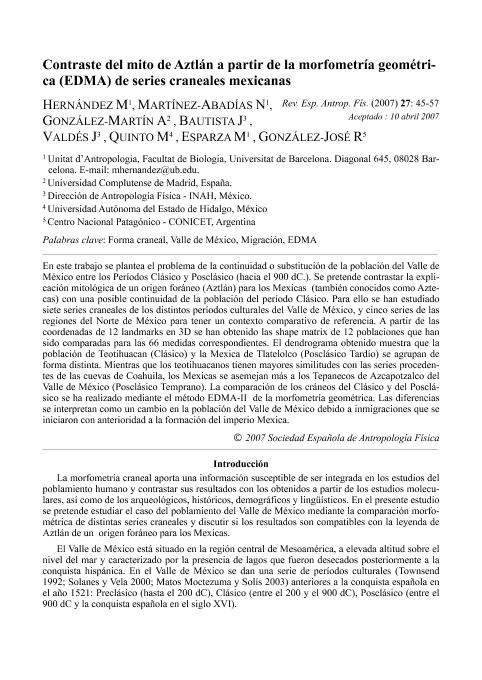Artículo
En este trabajo se plantea el problema de la continuidad o substitución de la población del Valle de México entre los Períodos Clásico y Posclásico (hacia el 900 dC.). Se pretende contrastar la explicación mitológica de un origen foráneo (Aztlán) para los Mexicas (también conocidos como Aztecas) con una posible continuidad de la población del período Clásico. Para ello se han estudiado siete series craneales de los distintos períodos culturales del Valle de México, y cinco series de las regiones del Norte de México para tener un contexto comparativo de referencia. A partir de las coordenadas de 12 landmarks en 3D se han obtenido las shape matrix de 12 poblaciones que han sido comparadas para las 66 medidas correspondientes. El dendrograma obtenido muestra que la población de Teotihuacan (Clásico) y la Mexica de Tlatelolco (Posclásico Tardío) se agrupan de forma distinta. Mientras que los teotihuacanos tienen mayores similitudes con las series procedentes de las cuevas de Coahuila, los Mexicas se asemejan más a los Tepanecos de Azcapotzalco del Valle de México (Posclásico Temprano). La comparación de los cráneos del Clásico y del Posclásico se ha realizado mediante el método EDMA-II de la morfometría geométrica. Las diferencias se interpretan como un cambio en la población del Valle de México debido a inmigraciones que se iniciaron con anterioridad a la formación del imperio Mexica. This paper deals with the problem of the continuity or else the replacement in the Basin of Mexico population during the transition from the Classic to the Postclassic period in Mesoamerica (which took place around 900 AD). The aim of this work is to contrast the explanation of the Mexicas (or Aztecs) foreign origin with its subsequent population replacement, with the alternative hypothesis that expects a biological continuity of the Classic populations that inhabited the Central Valley at the time of the Mexicas’ arrival. In order to test this temporal continuity, seven skull series belonging to the different cultural periods of the Valley of Mexico were studied. Moreover, five skull series from the North of Mexico were also analyzed to obtain a comparative reference context. The shape matrices of these 12 populations were obtained after the 3D coordinates of 12 cranial landmarks. Populations were compared by means of the 66 measurements generated from the euclidean distances among all possible pairs of landmarks. The dendrogram obtained after bootstrap resampling showed that the Teotihuacan series (from the Classic period) and the Tlatelolco Mexica series (from the Late Postclassic) were grouped into different clusters. Whereas the Teotihuacans were more similar to the northern series of the Coahuila caves (Candelaria and Paila), the Mexicas resembled the Tepanecos from Azcapotzalco in the Valley of Mexico (from the Early Postclassic period). The comparison between the Classic and Postclassic skulls was carried out by means of the EDMA-II geometric morphometric method. The differences obtained between these periods have been interpreted as morphological skull changes that occurred in the Valley of Mexico population as a result of the different immigrations that took place previously to the formation of the Mexica Empire.
Contraste del mito de Aztlán a partir de la morfometría geométrica (EDMA) de series craneales mexicanas
Título:
Contrast of Aztlán’s myth from geometric morphometrics of cranial Mexican series
Hernández, Miquel; Martínez Abadías, Neus; González Martín, Antonio; Bautista Martínez, Josefina; Gómez Valdés, Jorge; Quinto Sanchez, Mirsha Emmanuel ; Esparza, Mireia; González José, Rolando
; Esparza, Mireia; González José, Rolando
 ; Esparza, Mireia; González José, Rolando
; Esparza, Mireia; González José, Rolando
Fecha de publicación:
12/2007
Editorial:
Sociedad Española de Antropología Física
Revista:
Revista Española de Antropología Física
ISSN:
1887-2042
e-ISSN:
2253-9921
Idioma:
Español
Tipo de recurso:
Artículo publicado
Clasificación temática:
Resumen
Palabras clave:
FORMA CRANEAL
,
VALLE DE MÉXICO
,
MIGRACIÓN
,
EDMA
Archivos asociados
Licencia
Identificadores
Colecciones
Articulos(CCT-CENPAT)
Articulos de CTRO.CIENTIFICO TECNOL.CONICET - CENPAT
Articulos de CTRO.CIENTIFICO TECNOL.CONICET - CENPAT
Citación
Hernández, Miquel; Martínez Abadías, Neus; González Martín, Antonio; Bautista Martínez, Josefina; Gómez Valdés, Jorge; et al.; Contraste del mito de Aztlán a partir de la morfometría geométrica (EDMA) de series craneales mexicanas; Sociedad Española de Antropología Física; Revista Española de Antropología Física; 27; 12-2007; 45-57
Compartir



